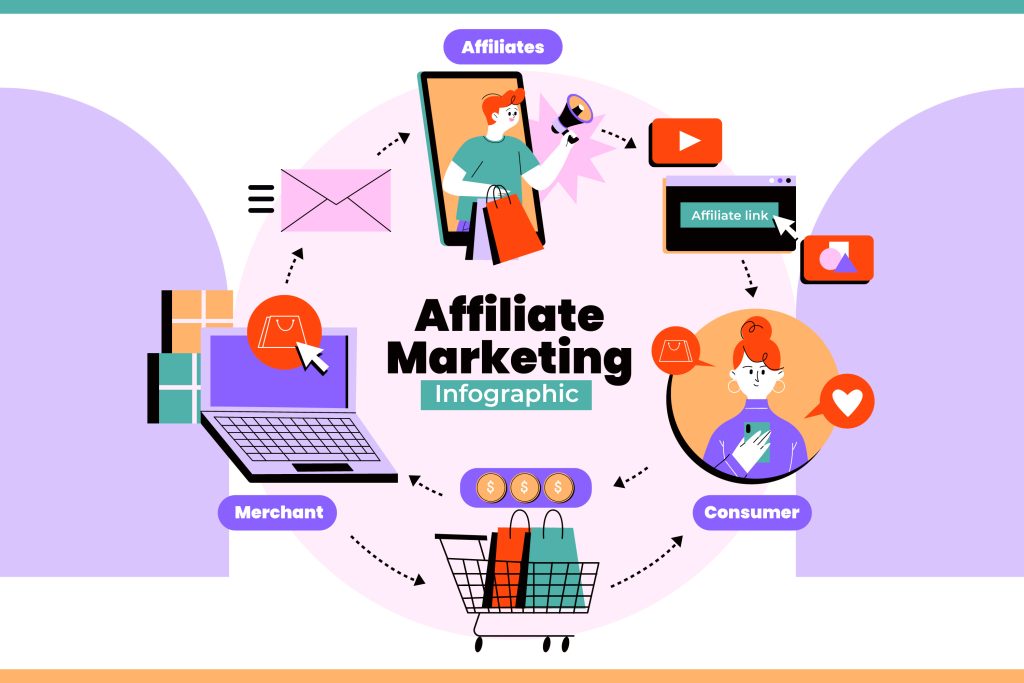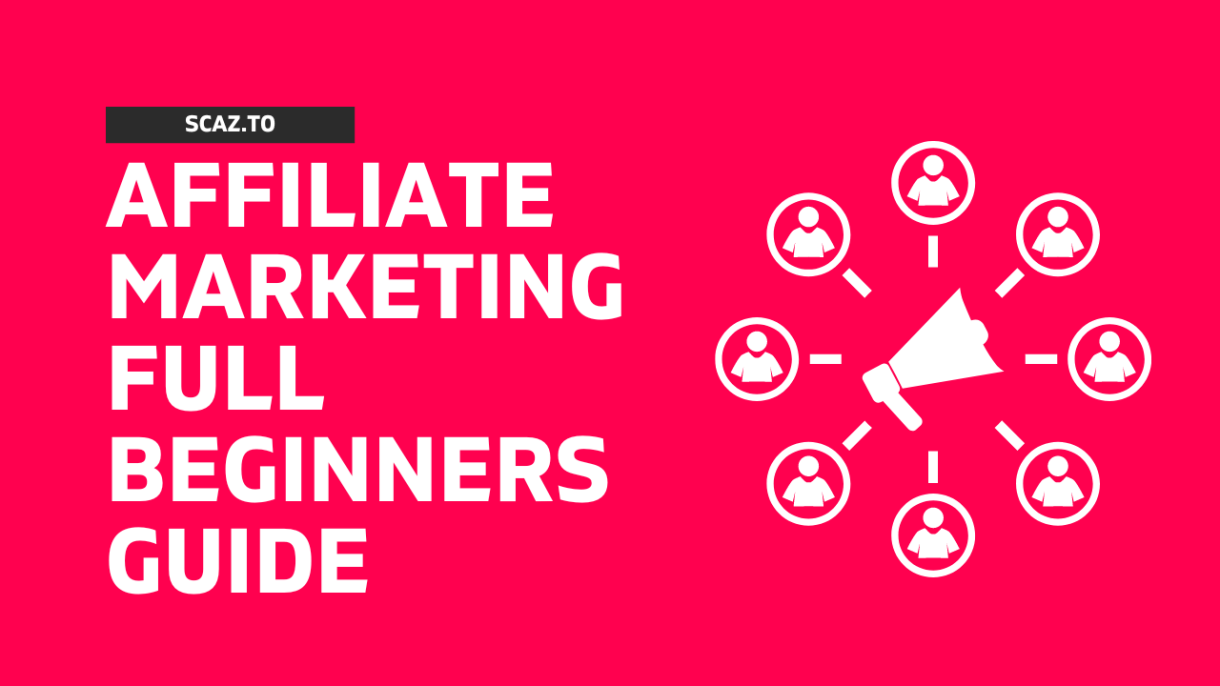Affiliate marketing is a great way to monetize your web traffic and earn extra income. It’s a versatile revenue stream that you can use no matter what your industry or niche is. In this comprehensive guide to affiliate marketing, we’ll show you exactly how to get started with affiliate marketing, grow your affiliate marketing business, and give you some tips to take your affiliate marketing business to the next level.
You’ve probably heard people promote affiliate marketing by saying something like “make money while you sleep”. While this is certainly possible, we wouldn’t be doing our job if we let you believe that affiliate marketing takes no work. Affiliate marketing is absolutely one of the best ways to generate passive (or nearly passive) income online, but it’s not going to happen if you don’t go about it the right way. Fortunately, this affiliate marketing guide contains everything you need to use affiliate marketing so you can wake up to a bigger bank account every morning.

What Is Affiliate Marketing?
Affiliate marketing is the process of promoting and selling another company’s products or services in exchange for a commission. It’s a simple enough concept, but the process itself can involve a lot of moving parts. At its core, though, affiliate marketing simply means that you sell someone else’s stuff and make money doing it.
How Does Affiliate Marketing Work?
We mentioned earlier that affiliate marketing is a simple concept, but there are a few moving parts to understand. With affiliate marketing, there’s a seller who creates an affiliate program and provides affiliate marketers with a unique link that the affiliates then use to promote the seller’s products. The links are unique to each affiliate marketer, so it’s easy to track who made the sale.
When someone clicks on the affiliate’s link, a cookie is placed on their browser. The cookie lets the seller know who sold the product and lets the affiliate earn a commission even if the person clicking the link decides not to buy right away. Cookies have an expiration date, so in order to get credit for a sale, the consumer must make a purchase before the cookie expires.
For example, let’s say you clicked on an affiliate link that has a 30-day cookie, but decided not to buy the product. A few days later, you go back and end up making a purchase. The affiliate gets credit for your purchase because it happened within the 30-day cookie window.
Who are the Parties in Affiliate Marketing?

Affiliate marketing involves either three or four parties, depending on the situation. The consumer pays the money. Each of the other parties takes a cut of that money. The relevant groups in these transactions are
The Product Creator (or Merchant) – these are the companies that provide products for sale. This party has several names: creators, merchants, sellers, brands, retailers, or vendors. In short, they have products they want to sell.
The affiliate network – this is the optional party on this list. Although some product creators interact directly with affiliates, many others use an intermediary instead. In fact, in some cases, such as Amazon, affiliate networks also act as retailers. Affiliate networks work with product creators to create a catalog of products that they make available for affiliates to sell.
The affiliate marketer – these people choose one or more products and encourage their online readers, viewers, or contacts to buy them. Affiliates can promote and create sales links on their websites (or even create dedicated sites to review the products) or social channels.
The consumer – ultimately, someone has to buy the products. The consumer notices the affiliate marketer’s recommendations, follows their customized links, and purchases the products.
How Do Affiliate Marketers Get Paid?
This is one of the most common questions we get about affiliate marketing. In general, affiliates are paid when a consumer completes an action, such as a form submission, click, or sale.
Per Sale
Pay per sale is the most popular affiliate marketing model. In this payment model, affiliates are paid for each sale they generate.
Per Click
In the pay-per-click affiliate marketing payment model, affiliates are paid for clicks generated, regardless of whether or not a sale was completed. This model is quite rare.
Per Lead
In the pay-per-lead model, affiliates are paid for the leads they generate.
Common Types of Channels Used in Affiliate Marketing
Affiliate marketers can drive traffic and sales in a variety of ways. Of course, some affiliate marketing channels are more popular than others. Here are some of our favorite marketing channels for affiliate marketing success.
Blogging
Blogging helps affiliates rank in search engine results and can drive traffic to affiliate offers organically (aka “for free”). Typically, bloggers use reviews, tutorials, how-tos, and other educational content to promote the affiliate’s product. They then link to the seller’s site using their unique affiliate link to get credit for the sale.
Influencer Marketing
Influencers are people who have a lot of influence over the people in their sphere of influence, typically on social media platforms like Instagram, YouTube, and Facebook. People follow influencers because they’re interested in what the influencer has to say, and they’re already primed to be open to trying whatever the influencer might be promoting.
Influencer marketing for affiliate sales can take many different forms, including live videos, product reviews, account takeovers, and more.
Paid Search Microsites
Microsites are branded pages (or a single page) that are separate from your main website. These sites are another way for you to provide detailed information and a sales pitch for affiliate products. Because they’re separate from your main website, you can offer a more targeted, relevant message that’s free from the distractions that typically come with a traditional website.
Email Marketing
Email marketing has been around for a long time, and for good reason. Email marketing ROI is high. Like, really high. Depending on which study you read, the numbers range from 3500% to 4000% return. That means you have the potential to make $35-$44 in revenue for every $1 you invest in email marketing.
For affiliate marketers, your email list can be a great source of potential affiliate sales. While you don’t want to sell, sell, sell with every single email you send, there’s nothing wrong with sending one promotional email for every three value emails you send. You can add your affiliate links to your email newsletters and watch the affiliate sales roll in.
Coupon Sites
Coupon sites have become increasingly popular in affiliate marketing since the rise of e-commerce and online shopping. Posting your affiliate links on coupon sites can bring in a lot of sales from the savvy shoppers out there.
Mass Media Sites
Mass media sites, or large media sites, are built to bring in tons of traffic. On these sites you’ll find reviews and comparisons of different products, many of which are affiliate products. These sites act as a repository of social proof for the products and services on them. They tend to promote products through banners and contextual affiliate links.
Benefits of Affiliate Marketing

(Almost) Passive Income
Outside of content creation and promotion, affiliate marketing can make you money at any time of the day or night, making it a nearly passive income option. And you don’t have to be actively involved in the transaction to make it happen. If you have a system in place to keep things running, you have the potential for a great return with very little ongoing effort.
Flexibility
Affiliate marketing gives you incredible flexibility to do what you want and still generate revenue for your business. You don’t have to create, manufacture, store, ship, or support the product – you just sell it. That means you don’t have to spend hours creating or promoting products. You simply choose products that you like and that you think your audience will like, create the content to promote those products, and then do the actual promoting.
Cost-effective
If you’ve ever wanted to start your own business, especially one that sells physical products, you know it costs money to get started. Sometimes a lot of money. With affiliate marketing, you have an inexpensive way to start your own business. As an affiliate marketer, all you have to think about is the time you’ll invest in creating content and promoting it.
Low risk
Following on from the previous benefit of affiliate marketing, affiliate marketing is also low risk. As an affiliate, you don’t have to invest any money to create, manufacture or store products. Your only job is to market and promote the products to your followers and paid traffic (if you choose to go that route). Even if you decide to promote affiliate products via blogging, you won’t be dropping a ton of money on something that you’ll be out if it doesn’t work out. There are tons of affiliate products and services to promote. If one is a dud, just move on to the next one.
No Customer Support
As an affiliate marketer, you don’t have to worry about customer support for the products and services you sell. This is a great relief for many affiliate marketers who want the freedom to start their own business without having to think about how to deal with actual customers. The only thing we’d like to stress here is that the products you promote to your followers should be quality products or services that you would actually use. If you push bad products on your audience just to make a quick buck, they’ll stop trusting you. So be selective about the affiliate products and services you promote.
How to Get Started With Affiliate Marketing
A quick Google search of “affiliate marketing” returns about 678 million results. Even if you narrow that down to “how to get started with affiliate marketing,” you’ll still find 88.5 million results. That’s a lot of content to wade through, especially since most of it is outdated, and a lot of what’s not outdated starts in the middle of the process. We’re going to start this affiliate marketing how-to from the beginning, so you can get started even if you don’t know what a “cookie lifetime” is or why it’s important (don’t worry, we’ll tell you). Let’s get started!
Step 1. Find a niche
The very first step in getting started with affiliate marketing is to choose a niche (or “vertical” if you want to sound super knowledgeable). This niche is what you’re going to “stock” your store with. And we’re not talking about a general store here. As an affiliate marketer, you want to be known for something.
This doesn’t mean that you promote just one product or service, like golf balls. Instead, it means that you could become an affiliate for the broader golf niche. Within this niche you could promote
- Golf equipment such as bags, clubs and apparel
- Online lessons and books
- Golf courses themselves, promoting memberships and day passes
- Professional golf stuff like tournaments, golf history, memorabilia
You get the idea, right? Here are some of the verticals you might want to explore:
- Hobbies such as photography, travel, sports betting
- Financial products such as debt management, investing, credit cards
- Wellness topics such as yoga, nutrition, organic products
- Lifestyle products such as fashion, luxury items, online dating
- Home and family topics like home security, baby products, gardening
- Tech stuff like SaaS, web hosting, VPN
- Alternative products like CBD, essential oils, personal development
What are you passionate about? What do you buy yourself? It’s a great place to start!
Step 2. Choose a Channel
After you’ve chosen your niche, you’ll want to choose at least one platform or channel to use for affiliate marketing. As we have already mentioned, blogging is probably the easiest and cheapest way to get started with affiliate marketing and can work for affiliates who want to write product reviews and comparisons to promote their chosen affiliate products.
YouTube is another great affiliate marketing platform. Plus, it’s free to start a YouTube channel and upload videos. The downside is that there are tons of other videos and creators on YouTube, so it can be hard to get your products noticed. Also, it’s likely to take a lot more time to create and upload a great video than it would to write a blog post. YouTube is definitely something to consider if you want to be on camera talking to people. And if you already have a following on YouTube, by all means use it for successful affiliate marketing.
Instagram is another place where you’ll find a lot of affiliate marketing action. It’s a very active platform and, like YouTube, it’s an absolutely brilliant option if you already have a following on the platform. You can create visually appealing images and videos to promote your affiliate products and, like other platforms, you can even pay for ads if you wish.
No matter which platform you choose, you’ll want to make it clear when you’re sharing an ad. We recommend including affiliate link disclaimers with all of your links. So on your blog, you’d link to your affiliate product and then add “affiliate link” in parentheses. On YouTube, include your affiliate disclaimer in your video description. For Instagram, using #ad or #sponsored is a great option.
Step 3. Choose the Products You Want to Promote
Now that you’ve chosen a niche and know where you want to promote your affiliate products, it’s time to choose the affiliate products you want to promote. Choose products with your target audience in mind and make sure you’re offering quality products that they will actually benefit from using. To make sure you’re on the right track, ask yourself if the products you’re considering will improve the lives of the people you’re promoting them to. Is it something you’d buy or something you’d tell your grandmother to buy? If the product or service passes these two tests, you’ll want to make sure you have a real chance to make money promoting it. What are the conversions and payouts for the product?
If nothing comes to mind, or you just want to see what’s out there, you can go to your favorite search engine and search for “your niche affiliate” and go from there. Or…
Step 4. Join an Affiliate Network or Affiliate Program
If you have a website and you’re already creating content, you’re ahead of the game. You can use your website’s analytics to find out who your audience is, then find products that will appeal to them and give you the payout you want. Joining an affiliate network or program gives you access to brands looking for affiliates, as well as tools to help you find the right opportunities. Some of the top affiliate networks include:
- ShareASale
- Awin
- Amazon Associates
- CJ Affiliate
- Rakuten Marketing
Affiliate networks give you access to hundreds, if not thousands, of affiliate programs to join.
How to Choose the Best Affiliate Programs?
There’s a lot that goes into choosing the best affiliate program for you. Here are some of the most important factors to consider when choosing the best affiliate programs for you and your audience.
Commission Type & Amount
If you want to make money from affiliate marketing, and we bet you do, the type and amount of commission you can earn is probably the most important factor for you. There are generally two types of commission structures: flat and recurring. The flat model is more common for physical products and involves a single, one-time flat payment per sale. With the recurring model, which is more popular for subscription products, you receive commissions each time the customer renews.
It’s also important to find out about the brand’s refund policy. Refunds are an inevitable part of shopping. But what happens if someone buys through your affiliate link and then asks for a refund? It’s important to know if you’ll be charged for the refund.
Cookie Lifetime
And here we are, back to the cookie lifetime we mentioned earlier. When we talk about cookies on the Internet, we’re talking about text files that contain small bits of data. These cookies are used to identify your computer when you use a network. If you’re considering affiliate marketing programs, you’ll want to know how long the cookie will stay on the shopper’s device. This is important because longer cookie life means you have a larger window of opportunity for a shopper to come back and make a purchase that will be attributed to you (so you get the commission).
So if someone uses your affiliate link and the cookie lasts one day, the shopper would have to complete a purchase within 24 hours of accessing your affiliate link. If the cookie lasts 30 days, the shopper could make a purchase two weeks after first accessing your affiliate link and the purchase would still be credited to you. The longer the cookie, the better for you.
Relevancy
Your audience is critical to your success in most things. And that’s definitely the case with affiliate marketing. Pick products that are relevant to your audience. Finding products that are relevant to your audience and have high payouts is even better. But don’t choose a product that’s not right for your audience just because it has a high payout. Not only will you damage your audience’s trust in you, but you probably won’t make any sales.
Payment Logistics
How will you get paid? Make sure you understand how often the affiliate program will pay you, where you’ll receive the money, and what currency they’ll pay you in. If you’re selling products with a recurring commission model, when will those payments be made? Is there a certain threshold you have to meet to get paid (e.g., payouts only happen when there’s at least $50 in commissions)?
Creative/advertising assets and conversion rates
Many times brands will offer creative assets like banners, graphics, and coupons that you can use to promote their products. These can be incredibly helpful assets to use. Other brands may just give you a text link. Check out the resources the brand provides. While just getting a link to promote might not be a deal-breaker, having to create these resources from scratch needs to be factored into your costs.
It’s also important to check out what’s on the other end of the affiliate link. Is it a boring landing page full of grammatical errors? A brilliantly designed video sales page? A landing page that looks like a box exploded with “SALE!” stickers all over it? The design of the page at the other end of the affiliate link can make a huge difference in your commissions. If the page isn’t built for conversions, it’s unlikely to get many.
The Competition
Another important thing to consider when choosing an affiliate program is the competition. How many people are selling the product? If the market seems overly saturated and the brand doesn’t seem big enough to support the drive for so many sales, you’re probably better off choosing another option.
Step 5. Create High-Quality Content
Okay. You’ve chosen a vertical and a platform, identified products to promote, and even joined an affiliate network. You’re ready to go! But now what? It’s time to create content.
The delivery of the content you create will vary depending on the platform(s) you’ve chosen to promote your affiliate products, but there are a few types of content you can count on:
- Product reviews: These are a staple of affiliate marketing and one of the easiest ways to get started. You can write your review as an article or a video, depending on the affiliate marketing channel you’re using. In your product review, share what you love and what you don’t love about the product (honesty is key to gaining your audience’s trust).
- Case studies: These take product reviews one step further. Case studies allow you to share a success story behind the product you’re promoting. It’s basically a “show” instead of a “tell” type of promotion.
- Tutorials: How-to articles and videos are great for showing your audience how to use an affiliate product or how you did something cool with it. Tutorials are actionable content and set your audience up for success.
- Product Comparisons: In a product comparison, you’d compare your affiliate product to another product that does the same thing and then give your honest opinion. It’s quite possible that the affiliate product may not be the best in some use cases, even if it’s the best product overall. Being honest just lets your audience know they can trust you.
- A resource page: These aren’t usually big drivers of sales, but they can be a way to get some extra income from affiliate marketing. Plus, it’s super easy to create a page with all the products you recommend and affiliate links for those products, so why not just do it?
Step 6. Generate Traffic and Build an Audience
Once you’ve created some content, you’re ready to start generating traffic and building an audience that will click on your affiliate links. There are three specific strategies that we recommend:
Build an email list
We’ve already told you about the ROI of email marketing, so it should come as no surprise that we recommend building an email list. Unlike your social media follower list, you own your email marketing list. So if your social network decides to stop letting people use it for promotions, you’ll still have access to your email list and can use it whenever you want.
The fastest way to grow your email list is to offer a lead magnet (something people get in exchange for giving you their email address). This can be a checklist, a free course, or any number of things that your audience will find useful and valuable. Once you have their information, you can send them valuable content along with promotional emails.
Search Engine Optimization
Search engine optimization (SEO) is important for driving organic traffic to your website. The idea is pretty simple: you target specific keywords that your target audience is interested in, create content on those topics, and make sure your site is indexed by Google, Bing, and whatever other search engines you want.
Paid traffic
Once you start making money, you can reinvest some of it in paid traffic. You simply create an ad (on a search engine or social media platform) and it draws people to your site. While it’s not a guarantee that you’ll get affiliate sales, it’s still a great way to build traffic and potentially get your site ranked higher so it’s found more often by the people who are interested in what you have to offer.
Tips to Improve Your Affiliate Marketing
Now you know all the basics (and some not-so-basics) of getting started with affiliate marketing. What’s next? You get started, of course! Here are some tips to help you get started and quickly ramp up your affiliate marketing efforts.
Start with product reviews
Start by reviewing products and services within your vertical. This will build trust with your audience and establish you as an expert in your niche. Be sure to let your audience know why they would benefit from the products you’re reviewing (or why they should stay away from them). Once you have a few product reviews under your belt, add product comparisons to the mix.
Stay up to date
There’s a lot of competition online and in affiliate marketing. To be the best, you need to stay on top of trends, not only in your vertical, but in marketing in general. If you’re a master of social media, you don’t want to be left behind when the next TikTok comes along.
Build trust with your audience
We’ve said it many times in this article: trust with your audience is paramount. Don’t betray that trust by pushing products they don’t want or need. Instead, focus on products that you truly believe will benefit your audience. And never tell them directly to buy – you are recommending products based on your expert opinion. Be helpful and recommend quality to keep your audience coming back for more.
Diversify your affiliate products
You don’t have to limit yourself to the affiliate products you promote. While you may have a particular seller that you love, it’s okay to work with other sellers and promote other products as well. This also protects you as an affiliate, since you won’t be left high and dry if the seller you love decides to cut commissions, limit the ways you can reach your audience about products, or eliminate their affiliate program altogether.
Test and Optimize
Test and tweak everything. All the time. Get to know your analytics and use them to inform your marketing and advertising. In marketing, you never really know for sure how something is going to work until you do it. So let things run for a while to gather data and then start tweaking. Pay attention to what works better and do more of it.
Get Started With Affiliate Marketing!
You now have everything you need to get started with affiliate marketing. You could even get started today, right now, if you wanted to! With the education, tips, and step-by-step process we’ve outlined here, we have no doubt that you’ll be able to launch your affiliate marketing career in no time.


